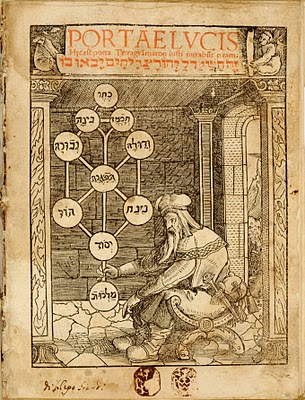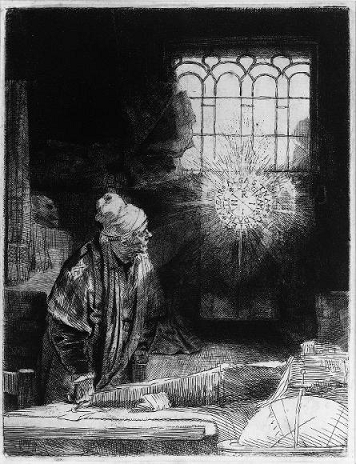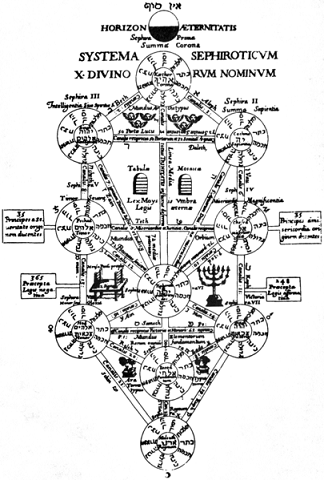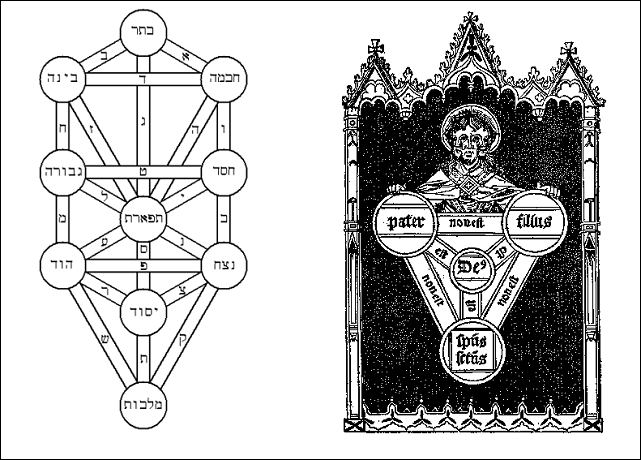A Rembrandt resemblance?
When I was searching for illustrations for my piece on ancient Sembl boards, I was under the impression that Rembrandt had made an illustration of some old sage having a vision of a slightly unusual form of the Sephirotic Tree of Jewish Kabbalah.
I wasn’t able to find it: what I did find, however, was a different but similar Rembrandt etching, showing a wise old man having a diagrammatic vision – but not of the variant Sephirotic Tree that I recalled seeing…
And although I could also have used Athanasius Kircher‘s highly wrought version of the Tree…
in the end I opted for a simpler diagram, which I juxtaposed to a Christian diagram of the Trinity:
 Okay, I went back to check on the Rembrandt, and found it on the Rijksmuseum site dated “c. 1652” with the comment:
Okay, I went back to check on the Rembrandt, and found it on the Rijksmuseum site dated “c. 1652” with the comment:
Faust?
What the etching exactly represents is unclear. In the early eighteenth century, the print earned the title ‘Dr Faustus’ and in 1791 Goethe used it on the title page for his publication of Faust. However, it is just as possible that this has nothing at all to do with Faust, but is a portrait of a scholar. It may be the ‘practising alchemist’ to which references were made in the seventeenth century. The posture of this ‘Faust’ has much in common with that of a scholar in an earlier print of Rembrandt’s. Rembrandt did not portray alchemists in the traditional way – that is, with fire. The enigmatic text in the radiating light could be a magic spell.
So here’s the business my unconscious seems to have had in mind during this whole process of searching in Rembrandt’s works for an image that resembled one of his etchings from around 1652.
I was conflating the Rembrandt with the image found on the title page of a book printed in Augsburg in 1516 — and that’s how the creative leap happens, in this case from a 1516 image in Augsburg to a 1652 image in Amsterdam.
At the point that I realize this, there’s an aha! in me, a Sembl move I can make linking the Portae Lucis title page to Rembrandt’s Faust etching – and a vista opening in the realm of art history, in which one could (and perhaps someone should) research the availability of the Ricius translation of Shaarei Orah to Rembrandt himself, and in the rabbinic libraries of his time in Amsterdam.
Because – and this is not art history but art historical hypothesis – the Ricius title page may well be a significant source of Rembrandt’s etching, of which the Rijksmuseum itself says:
What the etching exactly represents is unclear.
I have no idea how original an idea this is, and others may well have considered the possibility and researched the matter before me.
I do know that Rembrandt’s Jewish connections have been examined in detail, and would love to have seen the ‘Jewish’ Rembrandt exhibit at the Joods Historisch Museum.
But there you have it. The “unconscious” mind finds resemblances and in effect makes leaps, which the “conscious” mind then stumbles across – and on occasion those leaps deserve to be followed up, researched, confirmed or refuted.
In this case, I’m hoping my friend Michael Robinson will come to my rescue with some informed commentary – this is in his field, not mine.
In the meantime, the central rosette or mandala in the Rembrandt prominently features the letters INRI for Iesus Nazarenus Rex Iudaeorum (Jesus of Nazareth, King of the Jews), which was the title Pilate ordered nailed to the cross above Christ’s head in Hebrew, Latin and Greek (John 19.20). So even if Rembrandt had seen the Ricius Kabbalistic Tree diagram in the collection of one of his Jewish neighbors and been influenced by it, his own version is explicitly Christian…
And INRI, if you think about it, it a sort of Christian variant on the Tetragrammaton: a four-lettered title for Christ.
But that would be another possible Sembl move, for another day.




Charles, there is a vast literature on the print; in earlier inventories the work is called “alchemist, the first published reference to the plate as ‘Dr. Faustus’ is Röver, 1731. Perhaps the best recent brief summary of the literature is that in the BM’s recent catalogue, [Hinterding, Erik; Luijten, Ger; Royalton-Kisch, Martin, Rembrandt the Printmaker, London, BMP, 2000 #69] which reads in part:
“This etching, which dates from around 1652, is one of Rembrandt’s most puzzling prints. The question as to what precisely is depicted here still exercises experts and scholars after more than 300 years, and the interpretations are varied. In Clement de Jonghe’s inventory of 1679, the subject is concisely described as the ‘Practising Alchemist’, but in 1731 Valerius Röver referred to the print as ‘Doctor Faustus’, and it has been known by this title ever since [See De Hoop Scheffer & Boon 1971, p. 8, no. 33 and Van Gelder & Van Gelder-Schrijver 1938, p. 19]. Early in the twentieth century, Leendertz believed that he was able to substantiate the validity of this traditional title. He pointed to the fact that a Dutch version of Christopher Marlowe’s ‘Tragical History of Doctor Faustus’ was staged in Amsterdam in about 1650, and argued that Rembrandt’s etching represents the moment when a good angel, in the shape of a shimmering apparition, warns Faust not to enter into a pact with the devil [See Leendertz 1921, especially p. 140]. Others sought the solution elsewhere, and several later studies concentrated primarily on solving the riddle of the letters in the circle, which are – rightly – described as a Jewish mystical text, a cabalistic anagram [The last study in this series is Grothues 1992]. The most influential theory was that advanced by Van de Waal, who interpreted the traditional title of the print in an unexpected way. He argued that the etching does not depict Faust, but that it is the portrait of the founder of the Socinian sect, Faustus Socinus; the apparition in the window supposedly represents Socinus’ complex of ideas [Van de Waal 1974, pp. 133-81].
An entirely different reading of the work, and one that certainly merits consideration, was suggested by Lyckle de Vries. Drawing to some extent on earlier studies, he describes the print as an allegory of faith, illustrating a text from the Bible. In Paul’s first letter to the Corinthians, the apostle likens the limitations of human knowledge, as opposed to perfect, divine knowledge, to looking in a mirror at puzzling reflections – through a glass darkly (I Corinthians 13, v. 12). De Vries believes that the circle with Christ’s monogram and the mysterious text symbolizes the divine knowledge, which humans can see at best as if in a mirror, in other words indirectly and distorted, and even then cannot comprehend. In this interpretation, the cabalistic anagram has no function other than to be indecipherable. We thus see a scholar – a seeker after truth and representative of the faithful in general – who is being reminded by the apparition that human knowledge or wisdom is limited, and that it is only through Christ that we can partake of perfect knowledge in the hereafter [De Vries 1998].
Selected literature: Mariette 1857, p. 354; Leendertz 1921, pp. 132-41; Leendertz 1923-4, pp. 14-18; Benesch 1926, p. 9; Bojanowski 1938; Bojanowski 1940; Von Kieser 1940; Scholte 1941; Van Regteren Altena 1948-9, p. 11; Rehorst 1950; Rotermund 1957; Lehmann & Ettlinger 1958; Behling 1964; Boston-New York 1969, no. 11; Van de Waal 1974, pp. 133-81; Carstensen & Henningen 1988; Köhler 1982, pp. 10-12; Berlin-Amsterdam-London 1991-2, pp. 258-60, no. 33; Grothues 1992; Carstensen 1993, pp. 61-123; De Vries 1998.”
The ‘inspired’ scholar is a well known ‘type,’ much used in woodcut frontispieces as well as being found in painting – the woodcut you note is just one of many variants, it’s not the ur example. There is no doubt that Rembrandt knew of and was familiar with Durer, the ‘St Jerome in His Study’ (1514) is often cited as an influence on this plate. [In turn the atmosphere of Durer’s ‘Jerome in his Study’ recalls the painting ‘St Augustine in his Study (Venice, Scuola di S Giorgio degli Schiavoni), which Carpaccio had just finished when Dürer visited Venice for the second time in 1504-7.]
As well as having a substantial Jewish community, Amsterdam in Rembrandt’s day was the center of the European book and print trade and he could easily have seen or come across almost any earlier printed variant of the ‘scholar’ motif.
Thanks, Michael:
As always, I am indebted to you for your response.
I once heard Murray Gell-Mann speak at CalTech, and at the end of a brilliant and wide-ranging lecture he said that places like CalTech were highly proficient at producing specialists, but that our culture needed, and our educational institutions were not geared to produce, the kind of thinkers he described as “bridges” – people who could see analogies between specialist domains, and could then go to the experts to ensure their analogical bridges were well-founded in the domains in question.
So that’s the first lesson that your comment reinforces for me: that every analogy, every leap of resemblance that gives rise to a new hypothesis deserves testing.
Having said that, I’d like to push the issue a little further, and say that what distinguishes the Portae Lucis image from Durer’s Jerome in his Study as a potential precursor of the Rembrandt is the presence of a lettered diagram before the scholar’s gaze. St Jerome is no doubt in contemplative mood, but we do not see his object of contemplation – whereas in both the Portae Lucis and Faust images, the object of contemplation / vision / revelation is depicted, it is diagrammatic, and it contains elements of text. So rather than looking to a generalized “scholar” tradition for a precursor to the Rembrandt, I’d be interested to ask if there’s a tradition of scholars contemplating diagrammatic emblems of this kind.
More specifically, it seems that the diagram in question may be “cabalistic” in a sense which would include Christian adaptations of classical Hebraic Kabbalah, and also entirely plausible that Mirjam Alexander-Knotter is right (Rembrandt et la nouvelle Jérusalem: juifs et chrétiens à Amsterdam au siècle d’or, p. 314 -317) in reading the text of the rosette as if in the mirror to which a shadowy finger points us — and that the letters TETRMA which it can then be seen to contain may well be an abbreviated reference to the Tetragrammaton — another reference swhich would tie it to Portae Lucis. What seems indisputable to me, however, is that this rosette cannot represent the vision of a purely Jewish Kabbalist, since the letters INRI are irrefutably Christian in connotation.
Having written that, I wondered what Dame Frances Yates might have said on the topic, and found this, from her Occult Philosophy in the Elizabethan Age:
Scholars contemplating circular and circular lettered diagrams appear from the the early C16th. onward in woodcut illustrations and on the title pages of various recensions of Raymond Llull’s ‘Ars Magna’ or brief handbooks of Llullian method. There are also the famous engraved circular emblems or system illustrations of Robert Fludd, in smaller vignettes these are shown as diagrams, both inside and outside the silhouette head of the scholar.
Ah — excellent!
That’s the tradition I’d be interested in exploring, then — and would look to for the key precursors to the Rembrandt image.
And those are among the diagrams I’ve mentioned as precursors to “semantic networks” in general and Sembl boards specifically, for instance in our page here on “Sembl thinking, ancient boards” — where one of the illustrations is indeed of the silhouetted head with diagrams within and without.
Thanks again, Michael. As always, your scholarship and courtesy are warmly appreciated.
Well, I think the solution is:
MAGDALA MATER DEI
GENITA MARITA EST AL GRAAL
There is also a Spanish amulet that says:
MADRE MAGDALA
RAMITA LATENTE GRIAL ESTÉ GAEA
Read my booklet: FAUST VAN REMBRANDT in which I descripe why this must be the solution.
Ton Peeters